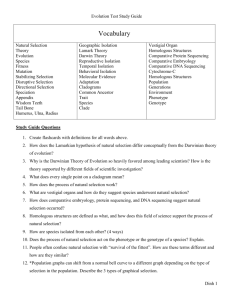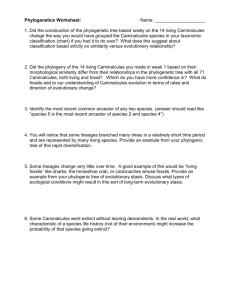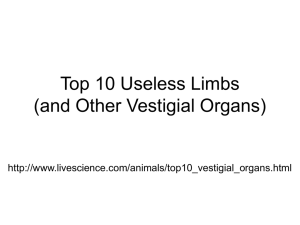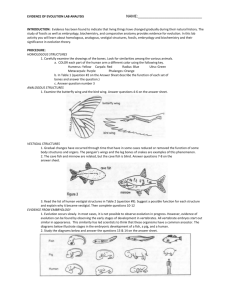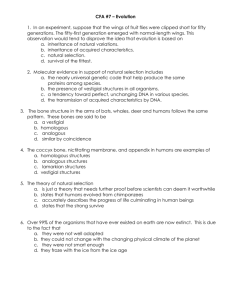Vestigial Structures in Humans
advertisement
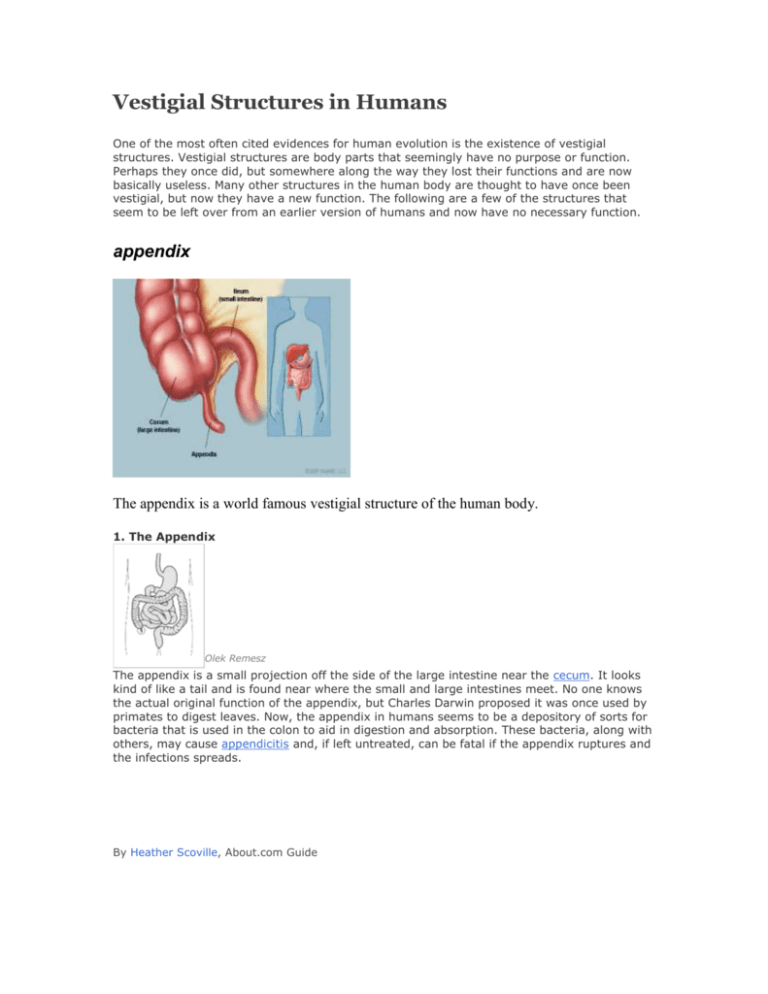
Vestigial Structures in Humans One of the most often cited evidences for human evolution is the existence of vestigial structures. Vestigial structures are body parts that seemingly have no purpose or function. Perhaps they once did, but somewhere along the way they lost their functions and are now basically useless. Many other structures in the human body are thought to have once been vestigial, but now they have a new function. The following are a few of the structures that seem to be left over from an earlier version of humans and now have no necessary function. appendix The appendix is a world famous vestigial structure of the human body. 1. The Appendix Olek Remesz The appendix is a small projection off the side of the large intestine near the cecum. It looks kind of like a tail and is found near where the small and large intestines meet. No one knows the actual original function of the appendix, but Charles Darwin proposed it was once used by primates to digest leaves. Now, the appendix in humans seems to be a depository of sorts for bacteria that is used in the colon to aid in digestion and absorption. These bacteria, along with others, may cause appendicitis and, if left untreated, can be fatal if the appendix ruptures and the infections spreads. By Heather Scoville, About.com Guide 2. The Tail Bone Grays Anatomy of the Human Body, 20th ed Attached to the bottom of the sacrum is the coccyx, or tail bone. This small, bony projection seems to be a leftover structure of primate evolution. It is believed that human ancestors once had tails and lived in trees. The coccyx would be where the tail was attached to the skeleton. Since tails on humans have been selected against in nature, the coccyx is unnecessary in modern day humans. Yet, it is still a part of the human skeleton. 3. The Plica Luminaris C hamiltonkolb Have you ever noticed that little flap of skin that covers the outside corner of your eyeball? That's called the plica luminaris, and it is a vestigial structure. It doesn't really have a purpose, but it is still there from our ancestors. It is believed to have once been part of a nictitating membrane. Nictitating membranes are like third eyelids that move across the eye to protect it or to moisten it as needed. Most animals have fully functioning nictitating membranes, although the plica luminaris is now a vestigial structure in some mammals. third eyelid The third eyelid or “the plica semilunaris” is a transparent membrane used for the protection of the eye and it is encountered most often at birds reptiles and fish, but some mammals have it too. What you probably did not know is that humans have vestigial third eyelids too. It is generally accepted that the small fold of tissue at the interior corner of the eye, which you might have noticed many times before is a now useless remaining of a transparent membrane we used to have in an early development stage. http://10awesome.com/10-vestigial-structures-the-most-controversial-human-organs/4. The Arrector Pili Grays Anatomy of the Human Body, 20th ed. When humans become cold, or sometimes scared, they get goose bumps. Goose bumps are caused by the arrector pili muscle in the skin contracting and pulling the hair shaft upwards. This whole process is vestigial for humans because we do not have enough hair or fur to make it worthwhile. Fluffing up hair or fur creates pockets to trap air and warm the body. It also can make the animal look bigger to threats that have scared them. Humans still have the response of the arrector pili muscle pulling up the hair shaft, but lack enough fur or hair for the response to actually work. Ear Moving Muscles The ear structure also shows evidence of a now useless ability. Most apes are capable of moving the ears so that they may hear better hearing and become aware of dangers. For humans, this ability became useless since long and the muscles responsible with moving the ears atrophied and are now ineffective. Some people are still able to move their ears, though. Can you? http://www.sharecare.com/question/are-wisdom-teeth-vestigial-organs The little toe Here we are “attacking” one of the most controversial items on this list. Is the little toe useful or useless? After reading and reading, I could not reach any conclusion on this one, so you might want to clarify things for me if you can! Some people consider that the fifth toe is absolutely vital for our balance, while others believe that it is only one of the vestigial structures of our body, as it was used for climbing, swinging and grasping and it does not affect balance either, so we will probably (and sadly) lose it at some point in the future … wisdom teeth They are one of the most clearly vestigial structures of the human body. Sometimes, these teeth do not manage to grow at all and continue to remain in the jawbone for the entire life of the owner. They are clearly vestigial, as they are useless when eating. Humans usually do not chew by using these teeth, because they are too far back in our mouths. They are a mere prove that humans evolved from primates who owned much larger mouths and were able to use those teeth. Wisdom teeth are considered a vestigial organ -- no longer useful -- because our diet has evolved. Early humans ate a mostly raw diet of foraged plants and hunted animals, which required a lot of rough chewing. That wore down their teeth. By the time wisdom teeth, the last molars, erupted between ages 17 and 25, their other molars and teeth had worn down, allowing room for the wisdom tooth to come in. With the introduction of cooking, our food got noticeably softer and our teeth remain in good shape. Also, modern orthodonture helps us keep a well-rounded mouth structure. As a result, there often is not enough room for wisdom teeth to erupt without damaging the other teeth, or else they may become impacted when they start to erupt and need to be removed. tonsils For many years, tonsils were considered totally useless and were removed without any second thought, if they got infected frequently. Today, however, we know that tonsils do have a role, as they stop bacteria from reaching our organism, as part of our immune system. This fact does not exclude them, though, from the list of vestigial organs of our body, as creationists consider. As I mentioned above, their opponents define vestigial structures as organs that lost their primary role, but may have kept however a secondary or minor role in the organism, thus including tonsils as well.
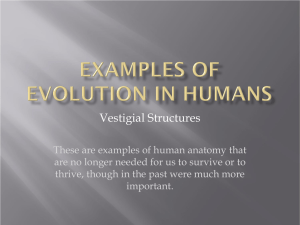
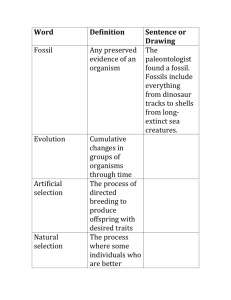
![2.3_the_top_10_vestigial_structures[1].](http://s2.studylib.net/store/data/010173220_1-31860a8aebbfa223def67eca3a90666c-300x300.png)

